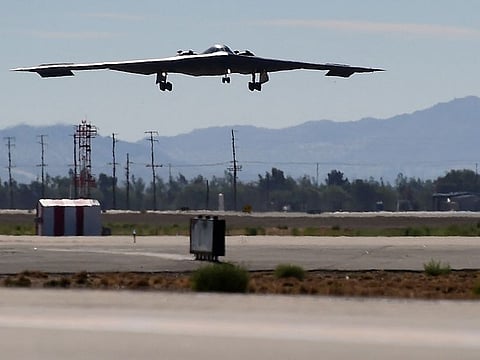Israel strikes Syria, US pounds Houthis in Yemen
US conducts B-2 bomber strikes on weapon storage facilities in Houthi-controlled areas

Jerusalem: Israel bombed a target in a Syrian coastal city on Thursday and the United States conducted strikes in Yemen nearly a month into Israel’s war with Hezbollah in Lebanon.
Syria, the Houthi rebels in Yemen, Hezbollah in Lebanon and Hamas in Gaza all belong to the so-called axis of resistance led by Iran, which on October 1 conducted a missile strike on Israel.
Israel has vowed to retaliate for Iran’s strike, sparking concern around the world that what is already a war on multiple fronts could morph into an all-out regional conflict.
Iran’s Revolutionary Guards chief on Thursday warned Tehran would hit Israel “painfully” if it attacks Iranian targets.
“If you make a mistake and attack our targets, whether in the region or in Iran, we will strike you again painfully,” Hossein Salami said in a speech.
Salami was speaking at the funeral of a Guards general who was killed in an Israeli strike on south Beirut last month that also killed Hezbollah chief Hassan Nasrallah.
According to Syrian state media, an Israeli strike on the city of Latakia, a stronghold of President Bashar Al Assad, wounded two civilians.
The Syrian Observatory for Human Rights, a Britain-based monitor, said the Israeli raid targeted a “weapons depot belong to Hezbollah”.
The Israeli military did not immediately comment on the strike when contacted by AFP.
Israel has conducted hundreds of strikes in Syria in recent years, including multiple attacks recently along the Lebanese border that seek to cut off Hezbollah’s main weapons and equipment supply route from Iran to Lebanon.
In Houthi-controlled areas of Yemen, Israel’s main ally the United States conducted multiple B-2 bomber strikes on weapon storage facilities, according to the US military and defence department.
“US forces targeted several of the Houthis’ underground facilities housing various weapons components of types that the Houthis have used to target civilian and military vessels throughout the region,” US Defence Secretary Lloyd Austin said in a statement.
The B-2 is a stealth aircraft capable of flying non-stop from the United States, with a payload of 40,000 pounds of bombs, the US Air Force says on its website. That is a far heavier weapons load than on most other modern warplanes.
The Iran link
Hamas sparked the Gaza war with Israel with its attack on October 7, 2023, which resulted in the deaths of 1,206 people, mostly civilians, according to an AFP tally of official Israeli figures.
In support of its ally Hamas, Hezbollah opened up a front against Israel by launching cross-border attacks from Lebanon last year.
The ensuing exchanges of fire forced tens of thousands of people on both sides to flee their homes.
With Hamas weakened but not crushed, Israel widened the focus of its operations to Lebanon, launching massive strikes on Hezbollah strongholds around the country and on September 30 sending ground troops across the border.
On Wednesday, Israel’s bombardment of Hezbollah targets toppled buildings and killed a city mayor in southern Lebanon.
Lebanon’s health ministry said 16 people were killed and 52 wounded in strikes on two municipal buildings in the southern city of Nabatiyeh, where Hezbollah and its ally Amal hold sway.
The strikes “formed a kind of belt of fire”, a local official told AFP who said the Nabatiyeh mayor was among the dead.
On Thursday, Israel issued an evacuation warning for civilians in part of the eastern Lebanese Bekaa valley, a traditional stronghold of Hezbollah.
‘Total destruction’
On Lebanon’s border with Israel, Hezbollah said Thursday it destroyed another Israeli tank, after close combat with soldiers staging incursions in the area.
Rescue workers affiliated with Amal in the southern city of Qana were digging through the rubble of several buildings destroyed in a bombing this week.
“More than 15 buildings have been completely destroyed, total destruction in a neighbourhood in Qana,” said Mohammed Nasrallah Ibrahim, one of the rescuers.
The war in Lebanon has left at least 1,373 people dead, according to an AFP tally of Lebanese health ministry figures, though the real toll is likely higher.
Israel’s government has come under criticism over its strikes in Lebanon, including from its ally the United States.
White House press secretary Karine Jean-Pierre said Washington had told Israel its operations should “not threaten the lives of civilians”, UN peacekeepers deployed in the country or the Lebanese military.
Sixteen European Union defence ministers called “for maximum political and diplomatic pressure on Israel” to prevent further incidents against peacekeepers.
Following a string of incidents last week, the UNIFIL peacekeeping mission on Wednesday accused Israeli forces of “firing at their watchtower” in a “direct and apparently deliberate” manner.
The Israeli military said later that it was not targeting UN peacekeepers.
Famine ‘risk’
In Gaza, Israel has faced international condemnation over the levels of aid reaching the besieged territory.
The UN agency for Palestinian refugees warned on Wednesday that there was “a real risk” of famine.
For over a week, Israeli forces have staged sweeping air and ground assaults in northern Gaza and the Jabalia area, saying that Hamas militants were regrouping there.
Nidal Al Arab, 40, lost 10 family members in Israeli strikes on Jabalia.
“People are trapped. If they don’t die of shelling, they will soon die of thirst and hunger,” he told AFP.
The head of the civil defence agency in northern Gaza, Ahmed Al Kahlout, said that more than 200,000 people have been “deprived of food aid for the 12th consecutive day, as well as potable water”.
The Israeli campaign in Gaza has killed 42,409 people, the majority civilians, according to figures from the health ministry in the Hamas-run territory, which the UN considers reliable.
Sign up for the Daily Briefing
Get the latest news and updates straight to your inbox

